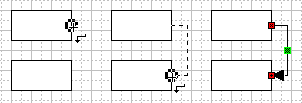
Connectors
A connector is used for tying two objects together. Its distinguishing characteristic is that the connection is maintained even when the objects are moved, resized, etc.

All connectors have the begin point and the end point (that is, they are 1D objects). You glue these endpoints to connection points of other objects to establish connection.

Note: You can always swap the begin and end points by choosing Reverse Link from the context menu.
There are 2 methods for gluing a connector to an object:
Connection to the entire object.
Position one the endpoints of the connector over the center of the object's alignment box, until a black rectangle appears round the object. On releasing the mouse button, a magenta square will indicate the point at which the connector is currently glued to the object. As you move the object, the point of connection will snap to the side of the alignment box nearest to the connector.

Connection to a connection point of the object.
Position one of the endpoints of the connector over the object, until you see a gray plus in a circle indicating the pointer is over a connection point of the object. Release the mouse button to establish connection. The glued endpoint turns red, indicating the place of connection.

To break a connection, just move the connector or its attached endpoint away from the objects.
Each object has 4 default connection points, in the middle of each side of its alignment box. They become visible when you position an endpoint of a connector over one of them and have the same effect as regular connection points.
There are 2 types of connectors: a smart connector and an object connector.

Smart Connector is composed of vertical and horizontal lines, which form a solid path. The main feature of the Smart Connector is that the point of connection changes its location when you move the object, keeping to the side facing the connector.
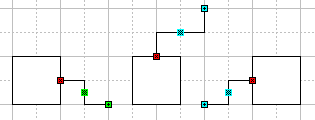
Control handles on the connector let you adjust its shape. The connector will keep its shape until you move one of the connected objects.
Use the connector tool ![]() to
create a Smart Connector. To get two objects connected straight away, start and finish
drawing the connector over connection points of the objects.
to
create a Smart Connector. To get two objects connected straight away, start and finish
drawing the connector over connection points of the objects.
Note: you may also press Ctrl+9, to switch to the connector tool.
Like other objects, a connector may have text in it. By default, the associated text appears on its central control point, or where the lines meet. The text may be then repositioned by using the Text Box tool.

Object Connector. Direct Connector.

An object connector can be created from any 2D object into object connector by simply changing it into a 1D object. Select the object, call the Behaviour dialog under the Format menu (Format/Behaviour) and check the 1-Dimensional option.
For a 1D object, dragging the endpoints affects its width and angle at once. By dragging the size handles, you control its height. If the rotate tool is on, the endpoints are substituted with rotation handles.
The most frequent variant of the object connector is a direct connector. You can draw
it with the help of tool Direct Connector ![]() . To get two objects connected straight away, start and finish drawing the
connector over connection points of the objects.
. To get two objects connected straight away, start and finish drawing the
connector over connection points of the objects.
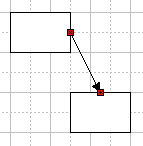
Connect Figures and Direct Connect tools.
![]()
![]()
Use Connect Figures or Direct Connect tool to connect one object to one or more other objects. The first one employs Smart Connector, the second one - Direct Connector.
How to use the tool: First select the object you want to connect to other objects (it will display green handles). Then, with the Shift key held down, select the objects to which the first object will be connected. Click the Connect Figures or Direct Connect button. The object with primary selection will be connected to the other selected objects.

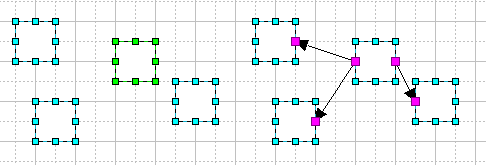
![]()
![]()
When in an auto-connection mode, all objects you draw or drop on the page get automatically connected to previous selected objects with an automatic connector. It doesn't matter whether you draw the objects yourself, paste from another application, take from a library, etc.
There are 2 connection modes: with a Smart Connector (Smart Connection Mode) and with a Direct Connector (Direct Connection Mode).
Auto-connection mode is very useful for quickly scetching large schemes. You don't need
to think about connections, just arrange them on the page.
For example, switch to Smart Connection Mode. Draw or select the initial element of the
scheme. Then, as you add new objects, they'll be automatically connected to the
previous selected object.
A connection point is a special kind of handle, to which connectors and control points can be glued. They look like red or blue crosses. Selected objects display their connection points in red, other objects - in blue. Note, that connection points may lie both on the perimeter of the object and outside it. Then red color helps us tell to which object the connection point belongs.
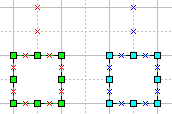
To work with connection points use the Connection Point tool ![]() .
.
Note: press Ctrl+0 to switch to the Connection Point tool.
Selecting objects.
When the Connection Point, you can select objects by clicking an object with the Cmd or Ctrl key held down. If you drag the object, you'll get its copy.
Creating connection points.
The main purpose of the Connection Point tool is to create new connection points. Select an object, and then click the object with the Connection Point tool in the place where you want the new connection point to be inserted.
Selecting, moving and deleting connection points.
Connection points can be edited (repositioned and deleted) with the Connection Point
tool. To select a connection point, move the mouse over it, so that the pointer changes
into ![]() , and click the mouse button. The
selected connection point becomes bigger and turns red.
, and click the mouse button. The
selected connection point becomes bigger and turns red.
To move the connection point, drag it with the mouse to a new location. To delete a
connection point, select it and click the Del key on the keyboard.
Preventing Connection points from displaying on screen.
In ConceptDraw, you may show and hide connection points. Under the View menu, uncheck the Connection points item to hide the connection points, and check the item to show them. Even when invisible, connection points remain operational.
Connection points inside a group.
You can work with connection points of objects which are part of a group. Normally, these connection points are not visible. But when you select an object in a group, its connection points appear in grey.

If you want to always see connection points in a group, enable Connection Points In Groups on the View menu.

Note, that connection points function even when they are not visible.